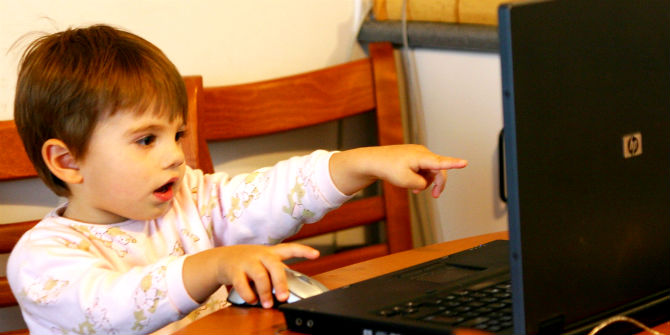Sonia Livingstone thinks that promoting children’s rights in the digital age is an idea whose time has come. She discusses why it is difficult to tell who is a child online, how these and other issues can be addressed, and how the iRights initiative and its five simple claims attempt to deliver children’s rights online. Sonia is Professor of Social Psychology at LSE’s Department of Media and Communications and has more than 25 years of experience in media research with a particular focus on children and young people. She is the lead investigator of the Parenting for a Digital Future research project.
‘Digital Rights Matter’ Day on 19 March 2015 set me thinking about whether or not children are included in online considerations of ‘human rights’. I think that they should be, but there’s plenty of statements and charters about digital rights that make no mention of children. When challenged, advocates often say that children are the responsibility of parents, and that there is no need for outsiders to intervene. But in relation to digital environments, parents often feel disempowered, and are now calling for action and intervention from those well-positioned to safeguard and empower children.
In a recent public lecture, I argued that, partly because it is difficult in practice to tell who is a child online, some real problems are becoming urgent:
- Children often use online services that are not targeted towards them but rather to adults, or where site or service providers are unaware of or negligent of the child’s status.
- Children often lack the digital (and other) literacies to navigate and evaluate the demands and norms of the online environment (where ‘buyer beware’ generally holds sway).
- As legal minors, children cannot technically enter into the contracts that companies implement online, and nor are they easily able to seek redress.
- Children have particular educational, cultural and informational needs that could be provided online, but that are not readily met through provision for the general public.
- Since they are below the age of sexual consent, children are particularly vulnerable to sexual exploitation and abuse, both online as well as offline.
How can these and other problems be addressed? In recent years, a new debate is developing at the intersection of three kinds of policy deliberation:
- Child welfare and rights organisations are extending their scope to embrace the internet, recognising the rapidity with which children are going online. This leads them to ask: are children’s rights to provision, protection and participation being met online?
- Experts in internet governance are recognising that many children are online, but the internet service and content providers cannot always tell when their users are children. This leads them to ask: can and should children’s rights be designed into online interfaces?
- As the internet opens up new ways for children and young people to engage with the wider world, many parents and teachers are also asking: what is their role? How can they find a balance between protection and participation that reflects the needs and capacities of the children in their care?
 Credit: L. Mamchenkov, CC BY 2.0
Credit: L. Mamchenkov, CC BY 2.0
To guide these linked inquiries, many turn to the UN Convention on the Rights of the Child. This is the most ambitious and most widely supported statement of children’s rights and, although it was developed long before the internet was a reality for most people, it applies remarkably well to the digital age. But the Convention is focused on states and, in relation to the internet, many stakeholders have a role to play, including parents, educators, government and industry.
One initiative, now gaining momentum, is iRights, the brainchild of renowned filmmaker and member of the House of Lords, Baroness Beeban Kidron. The idea developed from her many conversations with children around the country, and has crystallised into five seemingly simple claims:
- The right to remove. Every child and young person under 18 should have the right to easily edit or delete any and all content they themselves have created, and to have access to simple and effective ways to dispute online content about them.
- The right to know. Children and young people have the right to know who is holding or profiting from their information, what their information is being used for, and whether it is being copied, sold or traded.
- The right to safety and support. Children and young people should be confident that they will be protected from illegal practices and supported if confronted by troubling or upsetting scenarios online.
- The right to make informed and conscious choices (the right to agency). Children and young people should be free to reach into creative and participatory places online, using digital technologies as tools, but at the same time, have the capacity to disengage at will.
- The right to digital literacy. To access the knowledge that the internet can deliver, children and young people need to be taught the skills to use and critique digital technologies, and given the tools to negotiate changing social norms.
Disclosure: I joined the iRights advisory group a few months ago, hoping that this initiative would gain strength through the directness and appeal of the five rights and the importance of their objectives. In short, it seems to me – and to a growing number of supportive signatories, both individual and institutional – that promoting children’s rights in the digital age is an idea whose time has come.
But the path ahead is not necessarily all plain sailing.
Working out whether and how children’s iRights can be delivered by the different sectors of the internet industry (ranging from device manufacturers to content providers, from the huge global players to small companies up and down the country) is a challenge still in progress, especially if delivering children’s rights adds costs or reduces adult freedoms online, or has other consequences yet to be identified.
For parents and teachers, the language of rights can seem insensitive to a child’s particular needs or vulnerabilities, or neglectful of the cultural values that matter to particular families or communities. Who is to decide what balance suits which child, and what happens when rights – such as the right to agency and to safety – clash?
Last, there’s the question of compliance: can a civil society movement deliver? However much support it can mobilise, establishing shared norms of civility, inclusiveness and fairness in a fast-changing and complex environment will take time. And, as with all other multi-stakeholder initiatives, it must be independently evaluated. This should, of course, include the views of children themselves: iRights is now embarking on a process of youth consultation, with results due summer 2015 – so watch this space…






